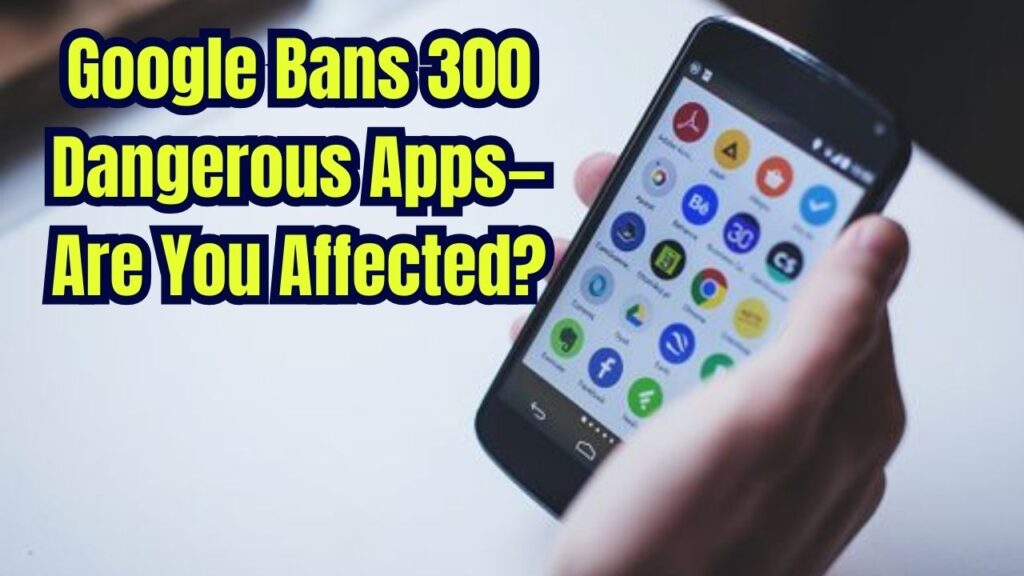
In a sweeping action to protect millions of Android users, Google removed over 300 malicious apps from the Google Play Store that had already been downloaded over 60 million times. These dangerous apps looked harmless on the surface—offering wallpapers, QR code scanning, or fitness tools—but underneath, they secretly collected data, bombarded users with spam ads, and even attempted financial fraud.
This article dives into what happened, how to check your device, and how to protect yourself moving forward.
Google Removes 300 Harmful Apps
| Topic | Details |
|---|---|
| Total Malicious Apps | 331 (Bitdefender Report, 2025) |
| Downloads | 60M+ globally |
| Impacted Devices | Android 13 and below |
| Countries Targeted | Brazil, U.S., Mexico, Turkey, South Korea |
| Threats Identified | Adware, spyware, fraud |
| Removal Action | All known apps removed from Google Play Store |
| Official Site | Google Play Store |
This incident is more than just a headline—it’s a reminder that digital vigilance matters. With over 60 million downloads and thousands still potentially at risk, it’s time for every Android user to review their apps and practice safe habits.
By following the steps above, you’re not just protecting your device—you’re safeguarding your data, finances, and peace of mind.
What Happened: 60 million Downloads, Hidden Threats
A major campaign involving 331 Android apps has been uncovered by cybersecurity researchers at Bitdefender, targeting users across five continents. The apps used stealthy methods like hiding icons and names, making them hard to uninstall. The primary goal? Generate ad revenue through fake clicks and steal sensitive user data.
“The majority of these apps are part of an ad fraud campaign, but some exhibited spyware behavior as well,” said Andrei Muresanu, Threat Analyst at Bitdefender.
How These Fake Apps Trick Users
These malicious apps follow a simple pattern:
1. Pretend to Be Useful
They appear as everyday tools—QR scanners, image editors, step counters.
2. Hide After Install
Some disable their icons or use system-looking names like “System Settings” to avoid suspicion.
3. Bombard With Ads
Even when not opened, they show full-screen ads, draining battery life and data usage.
4. Steal Information
Some secretly collect location data, credit card numbers, and login credentials.
How to Know If You Installed One
Here’s a practical, step-by-step guide for anyone—tech-savvy or not.
Step 1: Review All Installed Apps
- Go to Settings > Apps
- Look for anything unfamiliar or not recently used
Step 2: Uncover Hidden Apps
- Install a trusted app manager (like App Inspector)
- Search for apps with blank icons or suspicious permissions
Step 3: Run Google Play Protect
- Open Play Store
- Tap profile > Play Protect
- Run a full scan
Step 4: Delete Immediately
Remove any app that:
- Requests too many permissions
- Uses vague names like “Cleaner Pro”
- Causes performance issues
Step 5: Run a Security App
Trusted names include:
- Bitdefender Mobile Security
- Avast
- Kaspersky
Real-World Scenarios: How It Can Affect You
- John, a freelancer, noticed frequent ads popping up while working. A wallpaper app was to blame.
- Sophia’s 12-year-old son downloaded a step-tracker. It secretly logged their GPS location and sent it to a remote server.
- Carlos, an Android developer, learned his legitimate app was cloned by hackers and posted under a similar name.
A Note for Parents: Keep Kids Safe
Children often download apps impulsively. Here’s how to keep them protected:
- Enable Google Family Link
- Turn on Parental Controls in the Play Store
- Discuss digital safety with your kids: “Not every fun-looking app is safe!”
Developer Corner: A Warning for the Tech Community
Mobile app developers should also pay close attention:
- Your app’s reputation can be damaged by clones
- Maintain regular updates and user communication
- Use Android’s new App Signing and Identity Verification tools (see Android Developers)
Free Download: Mobile Security Checklist
Want a printable checklist to run a weekly mobile audit?
Download it here (Add download link when publishing)
Best Practices to Avoid Harmful Apps
| Do | Don’t |
|---|---|
| Download apps with 10K+ reviews | Trust apps with few/no reviews |
| Check permissions before installing | Ignore permission prompts |
| Update your Android version | Stay on outdated OS versions |
| Use antivirus & firewalls | Assume Google Play is 100% safe |
Expert Quote
“Even sophisticated users are vulnerable. These malicious actors are getting better at mimicking real developers. Vigilance is no longer optional—it’s a necessity.”
— Linda Hopkins, Mobile Security Lead, Avast
Frequently Asked Questions (FAQs)
Q1: Are these apps still available?
No. Google has removed all known versions, but they may still be on devices.
Q2: Can I reinstall from backups safely?
Not unless you’re 100% sure it’s the legit version.
Q3: How do I know if my data was stolen?
Monitor for strange account activity, or use HaveIBeenPwned.com
Q4: Should I factory reset?
Only if your device is severely affected or showing persistent malware behavior.







